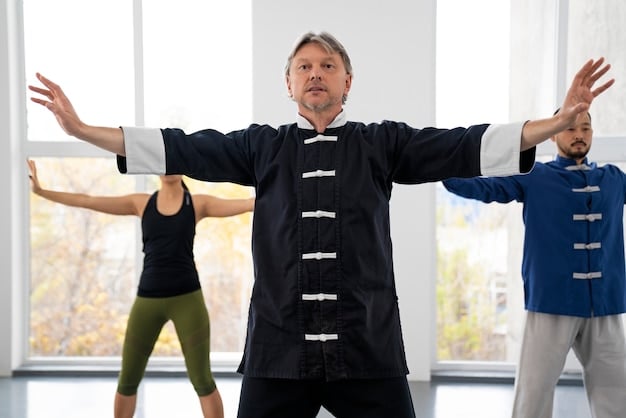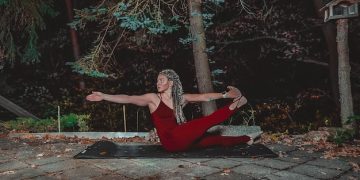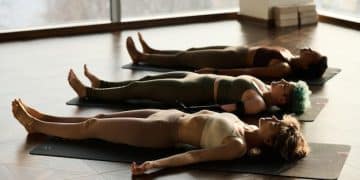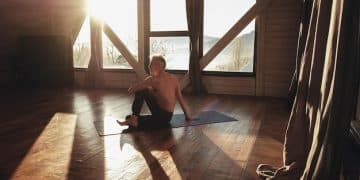Correct Your Practice: 5 Yoga Alignment Mistakes & Fixes

5 Common Yoga Alignment Mistakes and How to Correct Them Immediately address improper form in poses like Downward Dog and Warrior Two, offering corrections for safer and more effective practice.
Have you ever felt a twinge in your back during a yoga class or wondered if you were truly getting the most out of each pose? You’re not alone. Many yoga practitioners, from beginners to experienced yogis, unknowingly make alignment mistakes that can hinder progress and even lead to injury. Understanding these common errors and knowing 5 Common Yoga Alignment Mistakes and How to Correct Them Immediately is crucial for a safer, more effective, and ultimately more rewarding yoga journey.
Understanding Yoga Alignment
Yoga alignment is the precise positioning of the body in a yoga posture to promote safety, stability, and optimal energy flow. It’s about finding the most anatomically sound way to execute a pose, minimizing the risk of injury and maximizing the benefits. Good alignment allows you to fully engage the intended muscles, deepen your practice, and experience a greater sense of well-being.
Why is Proper Alignment Important?
Proper yoga alignment is not just about aesthetics; it’s fundamental to a safe and effective practice. When you’re correctly aligned, you distribute weight evenly, reducing stress on joints and preventing muscle strain. This allows you to hold poses for longer periods, explore deeper variations, and progress safely in your yoga journey.
- Injury Prevention: Correct alignment minimizes the risk of strains, sprains, and other injuries.
- Increased Stability: Proper alignment creates a stable base, allowing for better balance and control.
- Optimal Energy Flow: Alignment facilitates the flow of prana (life force energy) throughout the body.
Conversely, poor alignment can lead to a variety of issues, including joint pain, muscle imbalances, and chronic discomfort. It can also limit your ability to deepen your practice and experience the full benefits of each pose. By paying attention to alignment, you’re investing in the long-term health and well-being of your body.
In the following sections, we’ll explore 5 Common Yoga Alignment Mistakes and How to Correct Them Immediately.

Mistake 1: Rounded Back in Downward-Facing Dog
Downward-Facing Dog (Adho Mukha Svanasana) is a foundational pose that stretches and strengthens the entire body. However, many practitioners make the mistake of rounding their back in this pose, which can lead to shoulder strain and reduced hamstring stretch. This is one of the most 5 Common Yoga Alignment Mistakes and How to Correct Them Immediately we’ll explore.
Identifying the Issue
A rounded back in Downward Dog typically occurs when the hamstrings are tight, causing the pelvis to tilt backward and the spine to curve. This shifts the weight forward into the shoulders, creating tension and discomfort.
The Correction
- Bend Your Knees: Prioritize a straight spine over straight legs. Bending your knees allows you to tilt your pelvis forward and lengthen your spine.
- Engage Your Core: Actively draw your navel towards your spine to support your lower back.
- Press Through Your Hands: Distribute your weight evenly between your hands and feet. Spread your fingers wide and press into the knuckles.
By focusing on these corrections, you can transform your Downward-Facing Dog into a more sustainable and beneficial posture. Remember, it’s not about achieving perfect form right away; it’s about gradually improving your alignment and listening to your body.
Mistake 2: Knee Over Toe in Warrior Two
Warrior Two (Virabhadrasana II) is a powerful standing pose that builds strength, stamina, and balance. A common mistake in this pose is allowing the front knee to extend past the ankle, which puts excessive stress on the knee joint. This is another of 5 Common Yoga Alignment Mistakes and How to Correct Them Immediately that we will break down.

Spotting the Misalignment
If you look down and your knee is clearly in front of your ankle, you’re likely overextending. You should be able to see your big toe. This misalignment can lead to knee pain and instability.
Adjusting Your Stance
To correct this, focus on the following:
- Widen Your Stance: Increase the distance between your feet to create more space for your knee to bend safely.
- Engage Your Glutes: Actively squeeze your glute muscles to stabilize your hip and prevent your knee from collapsing inward.
- Keep Knee Aligned with Ankle: Ensure your front knee is directly above your ankle, forming a 90-degree angle.
Regularly checking your alignment in Warrior Two will help you develop proper muscle memory and prevent knee injuries. Remember to listen to your body and adjust your stance as needed. Proper alignment in Warrior Two not only protects your knees but also deepens the stretch in your hips and strengthens your legs.
Additional Tips for Warrior Two
Beyond knee alignment, remember to keep your torso upright, your shoulders relaxed, and your gaze focused over your front hand. Engage your core and breathe deeply to maintain stability and balance throughout the pose.
Mistake 3: Hyper-Extending Elbows in Plank
Plank Pose (Phalakasana) is a fantastic core strengthener, but it’s often performed with hyperextended elbows. Locking out the elbows puts excessive stress on the elbow joints and can lead to pain and instability. This is certainly one of most prevalent 5 Common Yoga Alignment Mistakes and How to Correct Them Immediately in a group class setting.
Recognizing Hyperextension
Hyperextension occurs when the elbow joint extends beyond its normal range of motion. In Plank, this often looks like a slight bend backward in the elbow.
The Solution
To avoid hyperextension, try these corrections:
- Micro-Bend Your Elbows: Maintain a slight bend in your elbows to engage the surrounding muscles and protect the joint.
- Engage Your Shoulder Muscles: Actively draw your shoulder blades down and back to stabilize your shoulders and elbows.
- Distribute Weight Evenly: Ensure your weight is evenly distributed between your hands and feet. Avoid sinking into your shoulders.
Incorporating these adjustments into your Plank practice will not only protect your elbows but also engage your core and shoulder muscles more effectively. Remember to listen to your body and modify the pose as needed.
Mistake 4: Collapsing Chest in Cobra Pose
Cobra Pose (Bhujangasana) is a gentle backbend that strengthens the spine and opens the chest. A common mistake is collapsing the chest forward, which compresses the lower back and restricts breathing. This is an important note on our discussion of 5 Common Yoga Alignment Mistakes and How to Correct Them Immediately.
Detecting a Collapsed Chest
If your shoulders are rounding forward and your chest is sinking toward the floor, you’re likely collapsing in Cobra Pose. This misalignment puts unnecessary pressure on your lower back and limits the opening in your chest.
Correcting Your Posture
To correct this, try the following adjustments:
- Engage Your Back Muscles: Actively draw your shoulder blades down and back, lifting your chest forward and upward.
- Press Through Your Hands: Use your hands to gently lift and support your upper body. Avoid locking out your elbows.
- Maintain a Long Neck: Keep your neck long and avoid crunching it backward. Gaze slightly forward.
Focusing on these cues will help you create a more supportive and expansive Cobra Pose, protecting your lower back and opening your chest. Listen to your body and adjust the height of the pose as needed.
Mistake 5: Incorrect Hand Placement in Triangle Pose
Triangle Pose (Trikonasana) is a standing pose that stretches the spine, hips, and hamstrings. An often-overlooked mistake is incorrect hand placement, which can lead to instability and misalignment. This final point in our discussion of 5 Common Yoga Alignment Mistakes and How to Correct Them Immediately focuses on providing a better form to your triangle pose.
Identifying the Problem
Many practitioners reach their bottom hand too far down the leg, often compromising the alignment of the spine and shoulders. This can lead to rounding of the back and restricted breathing.
Finding the Right Position
To correct this, focus on the following:
- Reach Towards, Not Down: Instead of reaching straight down your leg, imagine reaching forward and slightly up. This will help maintain a long spine.
- Use a Block: If you struggle to reach the floor without compromising your alignment, use a yoga block for support.
- Stack Your Shoulders: Keep your top shoulder stacked directly above your bottom shoulder. Avoid rounding forward.
By paying attention to your hand placement, you can create a more stable and aligned Triangle Pose, deepening the stretch and promoting greater spinal flexibility. Embrace the use of props to assist your poses and ensure you are getting the most out of your body.
| Key Point | Brief Description |
|---|---|
| 💪 Downward Dog Back | Bend knees to straighten spine, engage core, and distribute weight evenly. |
| 🦵 Warrior Two Knee | Widen stance, engage glutes, and align knee directly above ankle. |
| 肘 Plank Elbows | Maintain a slight bend in elbows, engage shoulder muscles, and distribute weight evenly. |
| 🐍 Cobra Chest | Engage back muscles, press through hands, and maintain a long neck. |
Frequently Asked Questions
▼
Proper alignment in yoga ensures that you’re distributing weight evenly, reducing the risk of injuries. It also optimizes the benefits of each pose, allowing you to engage the correct muscles and improve your flexibility and strength safely.
▼
Use a mirror to check your form, or record yourself to watch later. Pay attention to cues from instructors in online classes. Start slowly, focusing on one or two alignment points in each pose, and gradually build from there.
▼
Common injuries include knee pain (especially in Warrior poses), back pain (especially in Cobra or backbends), and wrist pain (especially in poses like Plank or Downward Dog). Proper alignment can help prevent these issues.
▼
Yes, props such as blocks, straps, and blankets can be incredibly helpful for improving alignment. They can help you reach the correct position without straining and support your body in poses where you may lack flexibility.
▼
Ideally, you should focus on alignment in every pose, every time you practice. Make it a mindful part of your routine. The more you focus on it, the better your muscle memory will become, and the more natural it will feel.
Conclusion
By understanding and correcting these 5 Common Yoga Alignment Mistakes and How to Correct Them Immediately, you can cultivate a safer, more effective, and ultimately more rewarding yoga practice. Remember to listen to your body, prioritize alignment over achieving the ‘perfect’ pose, and embrace the journey of continuous improvement. With mindful attention and consistent practice, you can unlock the full potential of yoga and experience its transformative benefits for years to come.





